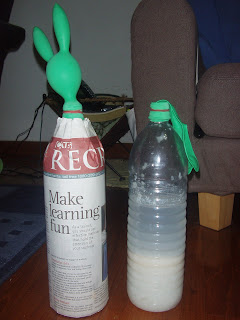Rice beer making has been both a fulfilling and enriching experience for us. In total, we did the experiment thrice, succeeding only at the last time. Here are the various trials that we went through:
1st Attempt
The first time we tried to make rice wine, as we were relatively new to the idea of making it, we did not manage to carry out the experiment properly. However, two useful things we found out from the experiment is that the ratio of rice to yeast should be 120g of rice to 1g of yeast, and the ratio of rice to water should be 1:3. We decided to use two bottles, one wrapped in newspaper, and one fully exposed to test whether the presence of light affected fermentation. We did not know exactly how to steam rice, hence we ended up with a batch of uncooked rice which was unused.
2nd Attempt
The second time we made rice wine, we managed to steam the rice properly!
 Cooked rice.
Cooked rice.We committed a mistake in this experiment, by overestimating the expansion of the glutinous rice, and hence we put too little rice and filled up the bottles with too little water, allowing for oxygen to enter the bottle. This enabled the yeast to carry out aerobic respiration, and thus, there could be the formation of ethanoic acid, and the results of experiment will thus be inaccurate.

Bottle half filled
to ferment.

 In addition, we did not weigh the rice and divide them equally into 2 portions. As a result, we just vaguely stuffed what we supposed was equal portions of rice into the bottles. It was a tedious task as the rice was sticky.
In addition, we did not weigh the rice and divide them equally into 2 portions. As a result, we just vaguely stuffed what we supposed was equal portions of rice into the bottles. It was a tedious task as the rice was sticky. Some error occurred in this experiement, leaving the bottle with light exposure to have a drastic decrease in the amount of gas in the bottle. Later, we discovered a mould sticking at the side of the bottle. It's formed from the rice that is exposed to the air which was not soaked in the water as we did not fill the water to the brim.
Some error occurred in this experiement, leaving the bottle with light exposure to have a drastic decrease in the amount of gas in the bottle. Later, we discovered a mould sticking at the side of the bottle. It's formed from the rice that is exposed to the air which was not soaked in the water as we did not fill the water to the brim. The balloon, with no air in it, is being sucked into the bottle itself due to lack of air.
The balloon, with no air in it, is being sucked into the bottle itself due to lack of air.After this experiment, we have learnt much on how to improve the experiment, and decided to make a conscious effort not to make these mistakes in the next experiment again.
Final Attempt
In our final attempt, we managed to do the experiment properly. Chou Yun's brother suggested that we experiment with temperature as well to make our experiment better-rounded. Therefore we have 2 setups with a total of 4 bottles.
We bought four 1.5 litre bottles and had to drink the water in the bottle as we felt it would just be wasting water to just pour it all down the sink. Firstly, we estimated the amount of rice that would fill a quarter of the bottle and multiplied that by four, which amounted to 600g of uncooked rice. Eventually, the rice expanded to about double and thus we just filled each bottle with 250g of rice and estimated it to be about a quarter of the bottle. After steaming the rice, we added 2g of yeast to each bottle. After that we fixed a heart-shaped balloon to each bottle and secured them with rubber bands to prevent air from escaping the bottles.

Next, we stored one wrapped and one unwrapped bottle behind the fridge and the other two in the fridge; however, we changed our minds and decided to put the two bottles in the room as we researched that the beer will take a very long time in such a cold temperature.
 A foolish decision made.. which was corrected later. :)
A foolish decision made.. which was corrected later. :) This is how the rice appears to be during the fermentation, having a slight colour change from white to brown.
This is how the rice appears to be during the fermentation, having a slight colour change from white to brown.Potential Errors
- With 2 bottles wrapped up by newspaper, it can cause different temperatures compared to their pair of bottles, causing inaccuracy of results.
- The amount of yeast in each bottle may not be exactly the same due to the small amount that is required, making it difficult to measure.
- Measurement of circumference is done by using strings, which may be inaccurate.
- There may be air leakage from the balloons as the particles of air are small enough to pass through the thin sheet of rubber giving inaccurate results
Now CHILDREN. After reading through the successful and not so successful experiments done by us, why not you try the experiment yourself? :D Be sure to take note on the potential errors and make your experiment as accurate as possible! Also open up all your senses! EXPLORE! DISCOVER! You may come by very interesting observations! HAVE FUN!! :)
No comments:
Post a Comment